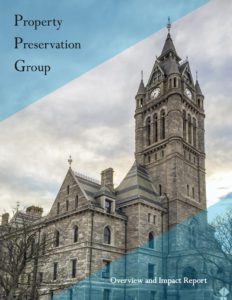Who is a member?
Our members are the local governments of Massachusetts and their elected and appointed leadership.

Holyoke Property Preservation Group report
By putting away their separate binders and embracing interdepartmental collaboration and technology, Holyoke officials have cleaned up dozens of blighted and vacant buildings and helped give new life to properties around the city.
Holyoke’s Property Preservation Group, which represents several city departments, has been meeting monthly since late 2015 to discuss Holyoke’s blighted, vacant and unsafe properties. By combining departmental resources, the group resolved 60 of 74 problematic properties between 2015 and 2020, according to a city report released early this year.
According to Holyoke officials, the combined efforts have resulted in greater efficiency and fewer duplicated efforts in addressing blight, the return of more properties to the city’s tax rolls, and improved quality of life for residents. In some cases, the group was able to resolve properties that had been in limbo for more than a quarter century.
“What the group has been doing, and the progress achieved to date, is a clear example of why it’s important for local governments to think outside the box,” said Mayor Joshua Garcia. “Our cross-departmental collaboration has resolved many properties that have been a nuisance for a very long time. … What we are witnessing with this group is responsible management of resources.”
When Building Commissioner Damian Cote came to Holyoke in 2012, departments were on separate pages about troubled properties. The Building Department had a three-ring binder of problem properties. The Board of Health had its own binder. And other departments had their own lists, which Cote eventually reviewed and combined into one. Meanwhile, previous group efforts to tackle blight in the city had fallen apart, Cote said.
“So all these departments were looking at things from different lenses and not working toward the same goal,” Cote said. “Or they were, but not even knowing they were working together toward it.”
Group participation is voluntary, but the monthly meetings regularly draw representatives from the building, fire, health, public works, law, planning and economic development, and community development departments. Garcia, who was sworn in as mayor last November, has also been attending recent meetings.
Having abandoned their physical binders, group members now refer to a collective spreadsheet that links to property information. Each month, the group reviews its updated “top 10” of properties needing attention, and decides on next steps. The properties have ratings based on input from Cote, the fire chief and the economic development director, with a focus on safety and economic value. The group then assigns tasks electronically to employees.
Resolving distressed properties may involve demolishing unsalvageable structures, renovating buildings, selling abandoned properties to buyers with rehabilitation plans, or redeveloping properties, Cote said. The city also has a property maintenance and demolition team, consisting of two employees trained in hazardous materials removal, to secure and stabilize properties.
The group’s five-year report describes numerous success stories. A two-family home, which owed more than $36,000 in back taxes at the time of its 2014 tax taking, is now privately owned, renovated and contributing $4,600 annually in property taxes. An abandoned property that had only a foundation now has an owner-occupied duplex. And an unsafe, vacant apartment building is undergoing a major renovation by a private developer.
Going forward, the group plans to focus more on prevention and preservation work, so properties don’t fall into such disrepair. For instance, Cote said, the group is looking at setting up funds to help new homeowners with their properties.
Cote said he also hopes to produce additional reports detailing the group’s progress. And Garcia said he hopes Holyoke can also pursue streamlined, citywide permitting among departments for property owners looking to develop in the city.